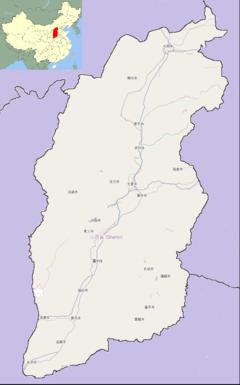Taiyuan
|
Taiyuan 太原市 |
|
|---|---|
| Prefecture-level city | |

|
|
| Nickname(s): Bīngzhōu (并州); Jìnyáng (晋阳); Dragon City (龙城) | |
 Taiyuan (red) in Shanxi (orange) |
|
| Location of the city center in Shanxi | |
| Coordinates: 37°52′10″N 112°33′37″E / 37.86944°N 112.56028°ECoordinates: 37°52′10″N 112°33′37″E / 37.86944°N 112.56028°E | |
| Country | People's Republic of China |
| Province | Shanxi |
| Divisions | County-level divisions: 10, Township-level divisions: 83 |
| Government | |
| • Party Secretary | Wu Zhenglong |
| • Mayor | Geng Yanbo |
| Area | |
| • Prefecture-level city | 6,959 km2 (2,687 sq mi) |
| • Urban | 1,460 km2 (560 sq mi) |
| Elevation | 800 m (2,600 ft) |
| Highest elevation | 2,670 m (8,760 ft) |
| Lowest elevation | 760 m (2,490 ft) |
| Population (2010 census) | |
| • Prefecture-level city | 4,201,591 |
| • Density | 600/km2 (1,600/sq mi) |
| • Urban | 3,212,500 |
| • Urban density | 2,200/km2 (5,700/sq mi) |
| Time zone | China Standard (UTC+8) |
| Postal code | 030000 |
| Area code(s) | 351 |
| ISO 3166 code | CN-14-01 |
| Vehicle registration | 晋A |
| GDP | ¥ 241.29 billion (2013) |
| GDP per capita | ¥ 50,802 (2010) |
| Major Nationalities | Han |
| Administrative division code | 140100 |
| Website | taiyuan |
| Tàiyuán | |||||||||||||||||||||||||||||

"Tàiyuán" in Chinese
|
|||||||||||||||||||||||||||||
| Chinese | |||||||||||||||||||||||||||||
|---|---|---|---|---|---|---|---|---|---|---|---|---|---|---|---|---|---|---|---|---|---|---|---|---|---|---|---|---|---|
| Literal meaning | "Great Plain" | ||||||||||||||||||||||||||||
|
|||||||||||||||||||||||||||||
| Transcriptions | |
|---|---|
| Standard Mandarin | |
| Hanyu Pinyin | Tàiyuán |
| Bopomofo | ㄊㄞˋ ㄩㄢˊ |
| Gwoyeu Romatzyh | Tayyuan |
| Wade–Giles | Tʻai4-yüan2 |
| IPA | [tʰâi̯.y̯ɛ̌n] |
| Wu | |
| Romanization | tha去nyoe平 |
| Yue: Cantonese | |
| Yale Romanization | Taai-yùhn |
| Jyutping | Taai3-jyun4 |
| Southern Min | |
| Hokkien POJ | Thài-goân |
Taiyuan (Chinese: 太原; pinyin: Tàiyuán [tʰâi̯.y̯ɛ̌n], also known as Bīng (并), Jìnyáng (晋阳)) is the capital and largest city of Shanxi province in North China. It is one of the main manufacturing bases of China. Throughout its long history, Taiyuan was the capital or provisional capital of many dynasties in China, hence the name Lóngchéng (龙城, "Dragon City").
The two Chinese characters of the city's name are (tài, "great") and (yuán, "plain"), referring to the location where the Fen River leaves the mountains and enters a relatively flat plain. Throughout its long history, the city had various names, including Bīngzhōu (并州) (from which the city's abbreviated single-character name Bīng (并) is derived), Jìnyáng (晋阳) and Lóngchéng (龙城).
During the Tang dynasty (唐朝) and subsequent Five Dynasties (五代), the status of the city of Taiyuan was elevated to be the Northern Capital, hence the name Běidū (北都), and Běijīng (北京, different from present-day Beijing).
Taiyuan is an ancient city with more than 2500 years of urban history, dating back from 497 BC. It was the capital or secondary capital (, ) of Zhao, Former Qin, Eastern Wei, Northern Qi, , Later Tang, Later Jin, Later Han, Northern Han. Its strategic location and rich history make Taiyuan one of the economic, political, military, and cultural centers of Northern China.
...
Wikipedia

